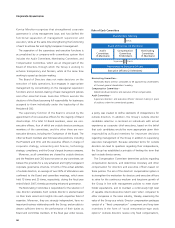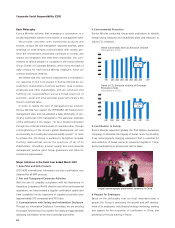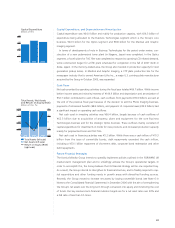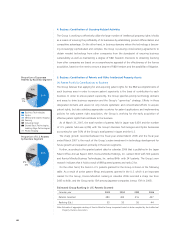Konica Minolta 2007 Annual Report Download - page 32
Download and view the complete annual report
Please find page 32 of the 2007 Konica Minolta annual report below. You can navigate through the pages in the report by either clicking on the pages listed below, or by using the keyword search tool below to find specific information within the annual report.
30
Corporate Governance
Konica Minolta recognizes that strengthened corporate
governance is a key management issue, and has clarified the
functional separation of management supervision and
execution, while at the same time strengthening the functioning
of each to achieve fair and highly transparent management.
The separation of the supervisory and executive functions is
accomplished by a company-with-committees system that
includes the Audit Committee, Nominating Committee, and
Compensation Committee, which are an integral part of the
Board of Directors, through which the Group is working to
enhance transparency and fairness, while at the same time
working to speed up decision-making.
The Board of Directors does not make decisions on the
execution of daily operations, but engages in appropriate
management by concentrating on the managerial supervision
functions and on decision-making of basic management policies
and other essential issues. Executive Officers execute the
decisions of the Board assuming full responsibility for businesses
assigned to them individually under the leadership of the
President & CEO.
The supervisory function of the Board is ensured by the
appointment of non-executive officers for the majority of Board
directorships. Of a total 13 Board members, seven are non-
executive officers, four of which are outside directors serving as
members of the committees, and the other three are non-
executive directors, including the Chairperson of the Board. The
other six Board members also hold executive positions, including
the President and CEO, and the executive officers in charge of
corporate strategy, accounting and finance, technology
strategy, compliance, and the Group’s largest business company.
Moreover, as all committees are chaired by outside directors
and the President and CEO does not serve on any committee, we
believe this provides for a very advanced and highly transparent
corporate governance structure. In terms of the actual activities
of outside directors, an average of over 90% of attendance was
confirmed to the Board and committee meetings, which were
held 13 times and 25 times, respectively, during the fiscal year
ended March 2007, thereby promoting enhanced governance.
The Nominating Committee is responsible for the selection of
new director candidates. Each outside director is elected based
on their track record and insights into each respective field of
expertise. Moreover, they are strongly independent, have no
important business relationships with the Group, and are able to
devote sufficient time to the performance of their duties as
Board and committee members. In the fiscal year under review,
a policy was created to define standards of independence for
outside directors. In addition, the Group’s outside director
candidate selection is centered on individuals with actual
experience as corporate chief executives, based on the belief
that such candidates would be more appropriate given their
responsibility as Board members for important decisions
regarding management of the Group in addition to supervising
executive management. Because extended terms for outside
directors can lead to questions regarding their independence,
the Group has established a principle of limiting the term that
each outside director serves.
The Compensation Committee determines policies regarding
compensation decisions, and determines monetary and other
compensation for directors and executive officers based on
these policies. The aim of the directors’ compensation system is
to strengthen the motivation for directors and executive officers
to strive for the continuous medium- and long-term growth of
the Group in line with management policies to meet share-
holder expectations, and to maintain a continuously high level
of capable director/executive talent even when compared to
other companies in the same industry, thereby maximizing the
value of the Group as a whole. Director compensation packages
consist of a “fixed compensation” component and long-term
incentives in the form of “stock remuneration-type stock
options” (outside directors receive only fixed compensation),
Nominating Committee—
Nominates Board director candidates to be approved by shareholders
at the next general shareholders’ meeting.
Compensation Committee—
Determines Board director and executive officer compensation.
Audit Committee—
Supervises directors’ and executive officers’ decision making in place
of auditors under the conventional systems.
Role of Each Committee
Shareholders’ Meeting
Audit
Committee
(5 Members)
Elects
Elects
Board of Directors (13 Members)
Representative Executive Officers
Executive Officers (21 Members)
Compensation
Committee
(5 Members)
Nominating
Committee
(5 Members)
Supervises
























